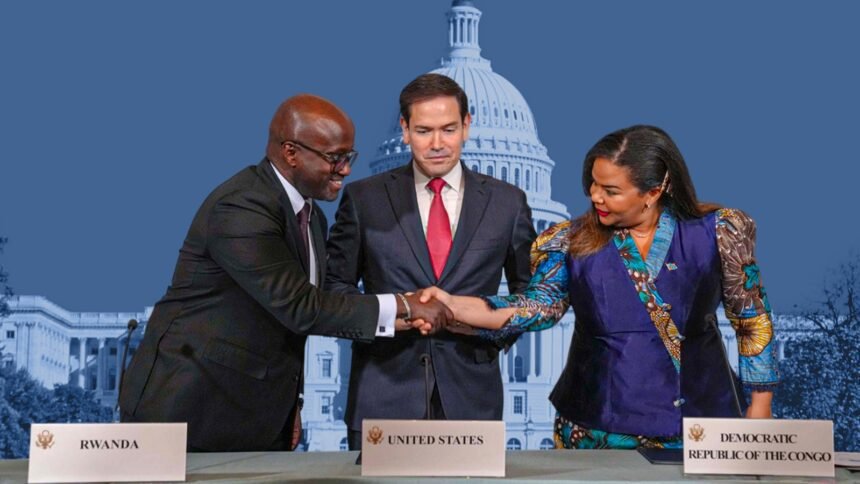On June 27, 2025, amidst the diplomatic grandeur of Washington D.C., the Democratic Republic of the Congo (DRC) and Rwanda formalized a peace pact—the so-called Washington Accord—in a ceremony mediated by the United States, Qatar, and the African Union. With Foreign Minister Thérèse Kayikwamba Wagner representing Kinshasa and Rwanda’s Olivier Nduhungirehe signing amid high hopes, the deal aims to end decades of conflict in eastern DRC and kick off economic integration.
The agreement includes Rwanda’s pledge to withdraw thousands of troops from the eastern DRC over a 90‑day timeline while the Congolese government commits to ending its support for the FDLR militia—the very group Rwanda has used to justify its military presence in the region. It also sets up a joint security coordination mechanism within 30 days and calls for a regional economic integration framework within 90 days, hoping to channel U.S. investment into the DRC’s vast mineral wealth.
To its promoters—including U.S. Secretary of State Marco Rubio, who called it a “new chapter of hope”—the deal represents a landmark shift. It’s being sold as a win for stability and prosperity, supposedly harnessing U.S. business and diplomatic muscle to bring peace and profit.
But layer by layer, the optimism peels away.
For starters, the agreement did not include M23, the Rwandan-backed rebel group that seized cities like Goma and Bukavu in early 2025. With M23 still holding enormous territory, many experts warn that the core conflict remains unaddressed. A separate declaration of principles between DRC and M23 was signed on July 19 in Doha, calling for a ceasefire, prisoner exchanges, and a comprehensive peace deal by August 18—but without direct inclusion in the Washington Accord.
That omission leaves a gaping hole. As Jason Stearns—an Africa specialist—points out, without M23 at the table, the terms risk being “diplomatic theater.” For many residents in eastern DRC, paper promises mean little if armed groups still run the streets.
Critics also highlight a glaring pattern: U.S. involvement tips heavily toward economic access. The accord ties mineral-rich Eastern DRC to American businesses, especially in cobalt, lithium, tantalum, copper and gold—materials vital to the global tech and clean-energy sectors. For U.S. billionaires like Jeff Bezos and Bill Gates backing KoBold Metals, this is not just diplomacy—it’s opportunity.
Yet analysts question whether commercial carrots can outweigh entrenched conflict incentives—especially in a region with hundreds of armed groups, deep corruption, and ongoing human rights violations.
A grim truth: eastern DRC remains a humanitarian crisis. M23 and other militias have displaced hundreds of thousands, killed thousands, raped women and girls, and kept civilians in constant fear. The United Nations’ Security Council Resolution 2773, adopted in February 2025, demanded immediate troop withdrawal from Rwanda and complete sovereignty for the DRC—but compliance has been murky.
Then there’s skepticism over enforcement. Rwanda’s President Paul Kagame publicly lauded the deal but warned Rwanda would act if requirements were not met. Meanwhile, Congolese officials reminded the U.N. that alleged Rwandan aggression continued and demanded accountability.
Even the Forum of Parliaments of the International Conference on the Great Lakes Region (FP‑ICGLR) hailed the accord as a “major breakthrough,” particularly for women and children who bear the war’s burden. But it cautioned that real change depends on turning commitments into real-world protections.
So, what’s actually happening on the ground? While political leaders cheer, little has changed in M23‑controlled regions. In many eastern towns, warlords still run checkpoints, state services remain absent, and aid access is blocked. A recent report described the Doha ceasefire as mostly symbolic, with violence still flaring in rebel-held territory.
This is the paradox of peace in central Africa: deals are signed, cameras flash, diplomatic rhetoric soars—but conflict endures because the real fighters remain unincluded or unreached by enforcement. The M23 ceasefire promise in Doha is a hopeful complement—but the true test will be whether August brings withdrawal, disarmament, and tangible calm—not just headlines.
Looking ahead, the fragile peace path hinges on three linked tracks:
1. Rwanda’s troop withdrawal and the dismantling of the FDLR in DRC territory—only then can Kinshasa credibly claim sovereignty.
2. Closure and integration of M23, with reintegration or disarmament, enforced through Doha negotiations.
3. Implementation of economic frameworks that prioritize local benefit—jobs, infrastructure, transparency—over resource grabs.
The Washington Accord holds potential—but also risk. If business trumps justice, or economic deals lead foreign capital into destabilized zones without safeguards, the result could be further exploitation without peace.
For now, eastern Congo remains a battleground: minerals promise hope, but mistrust spins the wheel of uncertainty. The accord may be a turning point, but only if enforcement outpaces optimism.










